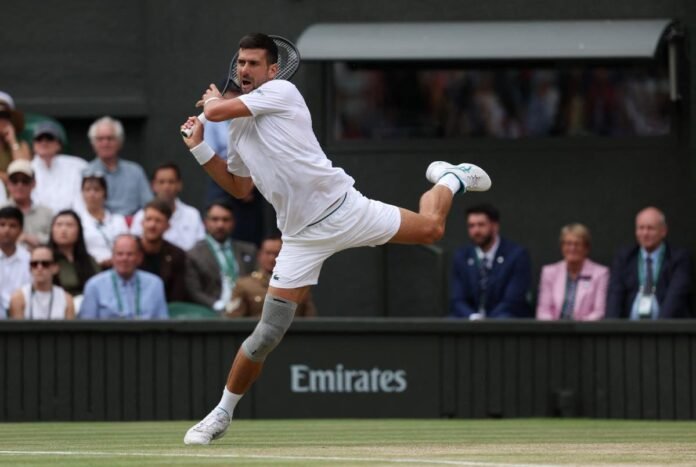The surprise of Sunday’s Wimbledon final isn’t that Carlos Alcaraz, the 21-year old wunderkind, routed the most accomplished player of all time in three mostly routine sets. It’s that Novak Djokovic, a 37-year old who had knee surgery six weeks ago, was there at all.
It’s a testament to what ridiculously good skills and tactical acumen Djokovic still possesses that he could make a Grand Slam final in such a physically questionable state. It’s also an indictment on the rest of the sport that only Alcaraz and Jannik Sinner, who beat Djokovic on his way to the Australian Open title earlier this year, seem capable of dealing with him.
At this point in his life, there’s little reason for Djokovic to still be out here other than an addiction to competition. The two most significant records in tennis – 24 Grand Slam titles and 428 weeks at No. 1 – are both his. With every year and every injury, the window of relevance shrinks a little bit more and gets harder physically to maintain.
But when you can still cruise to finals of big tournaments even as a much lesser version of the player you once were, maybe it’s worth it to keep going. Here’s the question for Djokovic, though: Is that going to be enough to keep him interested for much longer?


The reality of what we saw in Sunday’s 6-2, 6-2, 7-6 domination is that Djokovic is no longer at the same level as Alcaraz, the ascendant superstar who now owns four Grand Slam titles. Just as it always happens in sports, the torch wasn’t really passed: The young guy came and took it from the old guy. He’s not giving it back.
If Djokovic wasn’t particularly competitive with Alcaraz on grass – the surface where his game is probably most effective at this point – the path to beating him on more physical hard or clay courts seems quite narrow.
But what does it say about the field that Alcaraz could beat a diminished Djokovic so routinely while six other opponents never even came close to beating him?
The thing is, Djokovic wasn’t just bad on Sunday. Even the greatest ever can have bad days, and this was certainly a bad day.
The bigger problem is that Djokovic was ineffective. His game made no impact at all on Alcaraz, who was playing completely within himself at all times and yet was still controlling the rallies and manipulating Djokovic all over the court.
In last year’s final, Djokovic forced Alcaraz to be great. Twelve months later, Alcaraz just needed to show up with his baseline level, and it was more than good enough.
It leaves men’s tennis in an interesting place heading into the Olympics and the US Open. The field is so weak these days that Djokovic, at most, only needs to worry about a few players in any given tournament. But he’s also declined enough that his likelihood of beating those players in a physical best-of-five slugfest is now relatively small.
We’ll find out soon how that reality affects Djokovic’s motivation.
When he finished last year with a flourish, responding to his loss in the Wimbledon final by winning the US Open and the ATP’s year-end championships, Djokovic proved one final point about his greatness. But it also made him question how much more he was willing to grind to stay on top.
Djokovic showed up in Australia this January looking like he hadn’t put the time in during the offseason to get as fit as he normally is for the year’s first Grand Slam. He got winded easily, played some spotty tennis to get to the semifinals and then was dismissed by Sinner in four sets.
After that, he dismantled his longtime coaching team and decided not to play Indian Wells and Miami, the two big hard court tournaments in North America. He also acknowledged that his plan going forward was to play less frequently, spend more time with his family and focus almost exclusively on the Grand Slams.
So far, that plan has yielded an injury at the French Open that forced him to have knee surgery and a butt-kicking in the Wimbledon final.
For most anyone else, those results would be remarkable at any age and health status, much less 37 and injured. But for Djokovic, the only thing that matters is whether that’s enough to keep him pushing forward, knowing there’s not a whole lot more he can do to enhance his legacy.
This is Alcaraz’s sport now. But the gap between them in the Wimbledon finals was so big that it’s worth wondering how much longer Djokovic will try and stave off the end. He can beat almost anyone in the sport, but his days of beating this young tennis genius might be at an end.
Only Djokovic can answer how much longer that is worth grinding for when you’re the greatest to ever do it.
This article originally appeared on USA TODAY: Wimbledon rout by Carlos Alcaraz over Novak Djokovic shows talent gap
USA TODAY Sports







